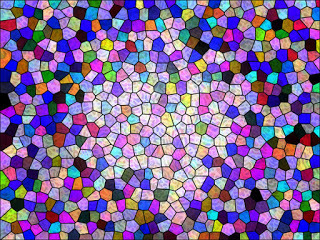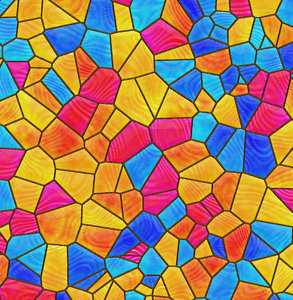Pearl Zhu's Blog, page 1424
July 5, 2015
Whole Brain Thinking
 According to the theory of left-brain or right-brain dominance, each side of the brain controls different types of thinking. Additionally, people are said to prefer one type of thinking over the other. It has been shown that in many ways the two parts of brain work separately yet without apparent conflict. Do they process information differently?
According to the theory of left-brain or right-brain dominance, each side of the brain controls different types of thinking. Additionally, people are said to prefer one type of thinking over the other. It has been shown that in many ways the two parts of brain work separately yet without apparent conflict. Do they process information differently?
Left-brain is more analytical; and right-brain is more intuitive: According to the left-brain, right-brain dominance theory, the right side of the brain is best at expressive and creative tasks. The left-side of the brain is considered to be adept at tasks that involve logic, language and analytical thinking. In general, the left and right hemispheres of our brain process information in different ways. The focus of the left brain is verbal, processing information in an analytical and sequential way, looking first at the pieces then putting them together to get the whole. Left brain thinking is verbal and analytical. Right brain is nonverbal and intuitive, using pictures rather than words. Is the Right Hemisphere more connected? Some research shows the left hemisphere doesn't have many connections to other parts of the brain as compared to the right hemisphere.The right hemisphere is the source of creativity, and it also has very far flung connections throughout the brain. And the innovative aha arises when original connections are made.
The human brain function is far too complex to be so simplistic as “half-half.” We all have the right and left halves of our brain connected by a dense jungle of neurons called corpus callosum which enable both the halves of the brain to talk to each other. The contention that we have a rational left brain and an intuitive, artistic right side is fable: humans use both hemispheres of the brain for all cognitive functions. The left brain/right brain notion originated from the realization that many (though not all) people process language more in the left hemisphere and spatial abilities and emotional expression more in the right. Psychologists have used the idea to explain distinctions between different personality types. In education, programs emerged that advocated less reliance on rational “left brain” activities. Brain-imaging studies show no evidence of the right hemisphere as a locus of creativity. And the brain recruits both left and right sides for both reading and math. Though in reality, individual differences in cognitive strengths. Some are more creative; others are more analytical than others.
 Totality is important. The brain is to mind as the eye is to sight. Brain is the hardware and the mind is the software with the totality in action, hardware plus software. The wholeness (hardware + software) is important to create quality thoughts. To look for the mind within the brain, seems then as silly as looking for the music between the strings of a piano. If we realize that the brain consists mostly out of “wires” guiding electrical impulses in feedforward- and feedback-controlled loops, that cannot even tell our senses apart, it is difficult to imagine where to find the mind. It might start getting far easier if we assume the mind as an emergent property, created, millisecond by millisecond, partially by the brain and partially by its environment. Mind - or 'consciousness' - is proposed as a 'quantum mind' by some physicists. Others, also reputed scientists dispute this, but invoke a more fundamental structure. According to social constructionism, the mind would more be between people, in their interaction.
Totality is important. The brain is to mind as the eye is to sight. Brain is the hardware and the mind is the software with the totality in action, hardware plus software. The wholeness (hardware + software) is important to create quality thoughts. To look for the mind within the brain, seems then as silly as looking for the music between the strings of a piano. If we realize that the brain consists mostly out of “wires” guiding electrical impulses in feedforward- and feedback-controlled loops, that cannot even tell our senses apart, it is difficult to imagine where to find the mind. It might start getting far easier if we assume the mind as an emergent property, created, millisecond by millisecond, partially by the brain and partially by its environment. Mind - or 'consciousness' - is proposed as a 'quantum mind' by some physicists. Others, also reputed scientists dispute this, but invoke a more fundamental structure. According to social constructionism, the mind would more be between people, in their interaction.To adapt to the over-complex, hyper-connected digital world, one needs to train self how to engage whole brain, to think both creatively and critically, analytically and synthetically, linearly and nonlinearly, to embrace more 'Aha Moment" for creating fresh ideas or identify 'trigger point" for decision making. So the whole-brainer is needed. Follow us at: @Pearl_Zhu
Published on July 05, 2015 23:46
Thinking Performance: Why and How to Measure it?
 People are the most invaluable asset in any organization anytime. However, the traditional performance management approaches more focus on measuring behaviors and quantitative result, with ignorance of qualitative assessment about character, mindsets, potential, multidimensional intelligence and culture effect. But in the forward-thinking organizations, the division between 'working' and 'thinking' is replaced by combining and integrating 'working and thinking' at both strategic and operational level, where people do the real work by unifying mind, heart and hands. So besides measuring behaviors, shall you also measure “Thinking Performance,” why and how to measure it?
People are the most invaluable asset in any organization anytime. However, the traditional performance management approaches more focus on measuring behaviors and quantitative result, with ignorance of qualitative assessment about character, mindsets, potential, multidimensional intelligence and culture effect. But in the forward-thinking organizations, the division between 'working' and 'thinking' is replaced by combining and integrating 'working and thinking' at both strategic and operational level, where people do the real work by unifying mind, heart and hands. So besides measuring behaviors, shall you also measure “Thinking Performance,” why and how to measure it?
Self-Assessment can help integrate Thinking Performance and Action Performance: It is important for employees to do self-reflection, self-assessment and self-improvement because the purpose of reviews is about improvement for the future. The past is over. Move the purpose of performance reviews away from "evaluating" the past, and to improve success in the future. It will stimulate employees thinking further about their authenticity, ambition, strength and innovation. This starts with the individual determining what goals s/he wants to achieve then; planning a way to get there; determining the milestones/measurements that signal whether it is going in the right direction and, if not, is flagging a warning that maybe the plan needs to be re-thought; the results is documented objectively with qualitative/quantitative measurements. The manager's role is to ensure the plans are in line with corporate direction, the individual has thought out the plans thoroughly; in such way, employees’ “Thinking Performance” is well integrated with their “Action Performance,” and their career goals are integral with organization's business goals.
Thinking Performance intends to improve business culture maturity: Culture is collective mindset, how organizations do things there. Every employee contributes to part of culture. “Thinking Performance” intends to assess the individual traits to culture. From example, can they come out of one's comfort zone and learn something new. Do they usually generate positive emotions such as passion, inquisitiveness, critical thinking or creativity; or they often release the negative emotions such as envy, jealousy, blaming, flattery, backbiting or rumor-mongering and so on. So the Thinking Performance helps to measure not only what has been done, but how to get it done, to adopt the right course of action and directly impact the individual, collective behavior and corporate performance as a whole. The intention is to remove all the negative energy if possible, and fill with positive ones to build a high-mature corporate culture, and get to the right action - learning, adapting and maturing. So Performance Management includes such things as optimizing the talents of employees at all levels, building a culture that supports the objectives the employees are to achieve, providing positive reinforcement and corrective feedback and linking behaviors to appropriate consequences, and aligning the organization for success
 Thinking Performance helps discover leadership potential of employees: Thinking Performance can make assessment on employee’s vision, cognition and creativity. A vision is a future state of being; it is a foresight with proactive understanding of cause and effect, not reactive sight. It is a clear choice among future scenarios that promotes certain behavior. The "aha" vision is an "entrepreneurial" attribute; the ability to envision a solution to a perceived or not-yet-perceived need. Thinking Performance covers two sides. It allows the employee to feel they are important and the organization is committed to their development (whatever that may be). It can drive both employees and supervisors thoughts on the process. It is not a management check in the box. It is required developmental conversations and plans that are conducted with valued team members. The whole concept is obviously more involved than just evaluating quantitatively.
Thinking Performance helps discover leadership potential of employees: Thinking Performance can make assessment on employee’s vision, cognition and creativity. A vision is a future state of being; it is a foresight with proactive understanding of cause and effect, not reactive sight. It is a clear choice among future scenarios that promotes certain behavior. The "aha" vision is an "entrepreneurial" attribute; the ability to envision a solution to a perceived or not-yet-perceived need. Thinking Performance covers two sides. It allows the employee to feel they are important and the organization is committed to their development (whatever that may be). It can drive both employees and supervisors thoughts on the process. It is not a management check in the box. It is required developmental conversations and plans that are conducted with valued team members. The whole concept is obviously more involved than just evaluating quantitatively.
Performance Management needs to be more innovative to optimize the process of continually aligning abilities, talents, aspirations, etc., to important work that an organization needs done and of engaging employees to think deeper about their career, and providing feedback to employees on how well the organization feels they are delivering on their commitments. This is a multi-directional dialogue around accountability, feedback and continual adjustment of expectations and future commitments. Thinking Performance + Action Performance intends to measure performance both qualitatively and quantitatively.
Follow us at: @Pearl_Zhu
Published on July 05, 2015 23:44
Three Aspects to Measure Organizational Maturity
 Organizations today are over-complex and hyper-competitive, management continues to run the business, but lack of insight on how well their organization is doing for long term. Is it functioning well or dysfunctional? Which management metrics shall you apply to measure organizational health and overall maturity. Who and what tools are being to measure if an organization is healthy or sick? Proactive or reactive? Intelligent or dumb? Customer-centric or operational driven?
Organizations today are over-complex and hyper-competitive, management continues to run the business, but lack of insight on how well their organization is doing for long term. Is it functioning well or dysfunctional? Which management metrics shall you apply to measure organizational health and overall maturity. Who and what tools are being to measure if an organization is healthy or sick? Proactive or reactive? Intelligent or dumb? Customer-centric or operational driven?
Engagement and performance measures: From performance reviews to surveys of employees and management, taken together, these can help define the organization. Some groups meet their management goals based on overwork, angry, team members who will quit as soon as the time is right. So the health of the organization is not good. Other groups / team meet their goals based on good teamwork, strong work ethic of people who love their job. So: perceived stress, engagement level, are hard indicators. It may be one method of assessing the health of an organization, but only if the turnover is appropriately qualified. Not only should you look at overall turnover, but first year turnover alone can be very telling. Also take a look at senior leader turnover by itself - especially first year senior leader turnover. Turnover 'could' be a measure, but if every organization in your location or industry is suffering high turnover, what will this tell you? High turnover for the right reasons is not a sign of poor health for the organization and neither is low turnover for the wrong reason a sign of good health. What constitutes high vs. low turnover is also subject to opinion and must be compared to something - historical averages for the company, compared to the industry, market, national averages, etc.- "hard" indicators, like sickness, requests for internal job rotation, claims regarding treatment/ performance, and subject of disciplinary measures, etc- then there are the engagement surveys-finally had been introduced a perceived stress level surveyAll measurements/ evaluations/ info need to be benchmarked before any interpretation, to the purpose to isolate the "real" signal. Sector and company average values are used.
Agility measures: HR departments sit on tons of data, the use of which hits the server and just stagnates. From an HR perspective, the vendor of a company's HRIS system needs to be leaned on to look at those that may tell stories. Beyond the HRIS metrics, many companies are using various things to help measure this. Just as with individuals, one can be healthy, but not necessarily productive. All the metrics may point in the right direction, yet productivity and performance may trend in other directions. What needs to be injected into the daily life of any organization may require more pointed investigation. Specifically looking for aspects of collaboration, knowledge sharing, and trust amongst other things, that relate to, but would not be a complete sampling of, organizational health. Attrition can be helpful and healthy for an organization, so it is important to define the context in which it is occurring. Only then will you know if the result is high or low, healthy or unhealthy.Overall, keeping track of following factors will help improve organizational maturity:-Safety Net: Know what it means to be on track; know when you've gone off track; know how to get back on track.-Communication Management: All communication, especially cross - functional, is collaborative. Trust, Transparency, Team satisfaction, Individual motivation, Individual Morale, etc.-Team Performance: Be guided by values and principles; have knowledge of practices. Work as a team rather than a collection of individuals.-Complexity Management: Eliminate unnecessary complexity (organizational structure), enhance necessary complexity (design complexity, social collaboration)-Knowledge Management: Inbuilt knowledge transfer, context management, information management., etc.
 Customer-centricity measures: An Organization’s Customer Centricity (CC) score is the measurement of gap. On one side of the gap is how well you understand your customers and on the other side is how well you deliver to your customers. The narrower the gap then the more CC you are. Once recognition of the gap exists then the journey starts towards CC starts. Measuring how well you are delivering to your customers is relatively easy but developing a true measure of how well one understands their Customers is the hard part. It is akin to measuring the difference between somebody knowing something versus understanding something.
Customer-centricity measures: An Organization’s Customer Centricity (CC) score is the measurement of gap. On one side of the gap is how well you understand your customers and on the other side is how well you deliver to your customers. The narrower the gap then the more CC you are. Once recognition of the gap exists then the journey starts towards CC starts. Measuring how well you are delivering to your customers is relatively easy but developing a true measure of how well one understands their Customers is the hard part. It is akin to measuring the difference between somebody knowing something versus understanding something.The problem with measurement is that more often, metric is very subjective. That is, from a scientific methods perspective, there is no way to run a real experiment to try one process against another. Each organization is different, but this will not stop an organization from measuring components of things that are measurable, just keep the measuring process not too rigid, focus on measuring things really matter, will the ultimate goals to improve organizational performance, agility and maturity.Follow us at: @Pearl_Zhu
Published on July 05, 2015 23:42
July 4, 2015
The Abundance of Wisdom: Do we Have it yet
 Digital is the age of abundance. There is abundance of data, abundance of information, and even abundance of knowledge. But, wisdom is at the top of knowledge life cycle: the abundance of data, information and knowledge is not automatically equal to the abundance of wisdom. Many times, wisdom is still in scarcity, for human as species to survive and thrive, wisdom is the most important thing to push the world forward. Is there any essential value, or virtue, or principle that people need to follow in life that can gain more wisdom?
Digital is the age of abundance. There is abundance of data, abundance of information, and even abundance of knowledge. But, wisdom is at the top of knowledge life cycle: the abundance of data, information and knowledge is not automatically equal to the abundance of wisdom. Many times, wisdom is still in scarcity, for human as species to survive and thrive, wisdom is the most important thing to push the world forward. Is there any essential value, or virtue, or principle that people need to follow in life that can gain more wisdom?
The source of human maturity is wisdom: Those who know best how to achieve and maintain high-EQ make wise decisions. To be wiser both individually and institutionally is necessary for everyone, especially for leaders. The wisdom you need is to find value in your experience - Wisdom comes from the experience of intelligence whether it be exterior or interior. You will do self-reflection via direct experience; you can also learn from others’ experience, but always do your best for validating; and don't be afraid to take an active roll on creating that experience so you can gain more wisdom and remember the more foolish it looks, the more there may be to learn. Decide what you are willing to put up with and let it rip and let the big U fill in the pieces to progress the story while you just make changes to the character you choose to be. To achieve wisdom, emotion has to merge with rational thought. The emotion of being in a particular situation is somehow stronger than witnessing someone else going through it, though we can learn from both. Empathy as one of the ingredients in wisdom is an important factor if we are to learn from the experience of others. There're many kinds of smarts or multidimensional intelligence, besides conventionally known IQ and EQ, a wise mind is also good at SQ - Strategy Quotient; CQ - Creativity Quotient; PQ - Paradox Quotient, and more.
True wisdom comes from taming these behaviours in one’s life: Envy, hatred, greed, self indulgence, selfishness, back-biting, rumor-mongering, placing boundaries around emotions and understating cause and effect. Wisdom is driven by a central logic that can be considered value judgement, intellectual maturity, universal love, thoughtfulness - considers consequences of one’s actions in regards to others. Wisdom is built around boundaries and definite measures of behaviour as it relates to entire environmental systems that allows continuation. Wisdom then comes down to self worth. Do to others as you wish them to do to you. But it is behaviour that takes into account the entire ecosystem which includes one’s behaviour. True wisdom is how you make this world a better place by fitting into a larger system of continuity.
 Intelligence is knowledge. Wisdom is understanding. Knowing others is intelligence; knowing yourself is true wisdom. Mastering others is strength; mastering yourself is true power. Wisdom leads to putting more thought into things and searching for flaws in decisions and that widens the possibility of coming up with alternative solutions. You could be very wise or very intelligent or both. It all depends on what you do with it and how you use it. Wisdom can come from the sheer desire to know an answer and seek it through study and practice. Intelligence is that ability to deduct quickly and come to logical conclusions, while wisdom is intelligence coupled with experience and emotional intelligence. Emotion comes into making wise decisions. Decisions made on a purely emotional basis can lead to unfortunate consequences, it needs to be rationalized. Wisdom is also found in discovering the path that leads to your goal and sometimes that takes a little emotional kick here and there to get you speed up to do something.
Intelligence is knowledge. Wisdom is understanding. Knowing others is intelligence; knowing yourself is true wisdom. Mastering others is strength; mastering yourself is true power. Wisdom leads to putting more thought into things and searching for flaws in decisions and that widens the possibility of coming up with alternative solutions. You could be very wise or very intelligent or both. It all depends on what you do with it and how you use it. Wisdom can come from the sheer desire to know an answer and seek it through study and practice. Intelligence is that ability to deduct quickly and come to logical conclusions, while wisdom is intelligence coupled with experience and emotional intelligence. Emotion comes into making wise decisions. Decisions made on a purely emotional basis can lead to unfortunate consequences, it needs to be rationalized. Wisdom is also found in discovering the path that leads to your goal and sometimes that takes a little emotional kick here and there to get you speed up to do something.
The ultimate aim of learning knowledge is to gain wisdom. And wisdom is the most crucial element to transform human society for betterness. From the wisdom, the growth has manifested in practicing kindness: Respect instead of control. Humility instead of status quo. Self-control instead of self-indulgence. Forgiveness instead of revenge.
Follow us at: @Pearl_Zhu
Published on July 04, 2015 22:57
Is the Best Customer Experience a Sequence of Event or a Seamless Continuum
 Digital is the age of customers. Customer Experience is vital for growth, development and to make sure you stay in business, Both retaining a customer and winning a new customer are very important to every business’s surviving and thriving, Should customer journey be represented as a set of discrete events or experiences or is it actually a seamless continuum? Shall you take inside-out or outside-in view to observe customer? Is Customer Experience an integral ingredient of business strategy? And how do you manage it more effectively?
Digital is the age of customers. Customer Experience is vital for growth, development and to make sure you stay in business, Both retaining a customer and winning a new customer are very important to every business’s surviving and thriving, Should customer journey be represented as a set of discrete events or experiences or is it actually a seamless continuum? Shall you take inside-out or outside-in view to observe customer? Is Customer Experience an integral ingredient of business strategy? And how do you manage it more effectively?
Outside-in view is crucial to look at the the customer experience: Organizations often spend too much time on planning the journey and the interactions a customer may encounter. When look at the customer experience from the inside out, there is nothing wrong with that because employees are the ones that can change the inside. But the customer's experience is about how they encounter, observe, or undergo a company's events or stages. When you lay out a journey that you hope is helpful, positive, and shares the experience with your customers. They may not like, appreciate, or really care about the journey or simply may not go through the journey in the "correct" way.
Most of the time, Customer Experience is a sequence of events. But the sequence helps you understand the overall experience. The sequence is like the journey. Define what the BEST customer experience is leads to a positive emotional reaction, a “WOW” factor. One experience can be enough. After that you have to create a relationship, to maintain positive behavior of the customer (loyalty, word of mouth, positive influence on employee engagement, etc.). If the sequence of events is based on "outside in" data and the end result is to transform the company or organization to increase its customer centric maturity, and build a culture to focus on creating value for their customers, then it is a sequence of experiences or simply a strategic plan. Let the customer touchpoints land where they may achieve the results. And beyond the emotional WOW, the experience is effortless (easy), productive ( achieved objective) and painless (frictionless). And there is consistency over time in the delivery of the experience.
 The other important factor to improve Customer Experience is a "Voice of the customer"; or a VOC program where you do research into what the customer really wants. When you really understand (or attempt to understand) what the customer would say they want and what you found they actually want, it is when you can really develop an experience that fits them and their needs or desires. Invariably, the total customer experience is typically comprised of a complex set or series of interrelated processes or steps. The best Customer Experience occurs when an organization’s processes are so well integrated or orchestrated that the customer experiences are a ‘near-seamless’ experience – it is the application of one-piece flow to the customer experience and it is best summarized by the quote: “Whoever picks up the phone, owns the call.” The most useful question is: "What is the set of experiences that, if provided, will cause customers from the targeted segment to choose your product over the best competing alternative?" Best practice teams infer the winning set of experiences after walking a mile in customers' shoes to understand what is hard, complex, expensive, risky and annoying as they attempt to deliver value to their customers.
The other important factor to improve Customer Experience is a "Voice of the customer"; or a VOC program where you do research into what the customer really wants. When you really understand (or attempt to understand) what the customer would say they want and what you found they actually want, it is when you can really develop an experience that fits them and their needs or desires. Invariably, the total customer experience is typically comprised of a complex set or series of interrelated processes or steps. The best Customer Experience occurs when an organization’s processes are so well integrated or orchestrated that the customer experiences are a ‘near-seamless’ experience – it is the application of one-piece flow to the customer experience and it is best summarized by the quote: “Whoever picks up the phone, owns the call.” The most useful question is: "What is the set of experiences that, if provided, will cause customers from the targeted segment to choose your product over the best competing alternative?" Best practice teams infer the winning set of experiences after walking a mile in customers' shoes to understand what is hard, complex, expensive, risky and annoying as they attempt to deliver value to their customers.You have to put the customer at the heart of everything that you do as a business, great Customer Experience Management is a differentiator for companies. It also has to be driven as a culture within the company starting at Board level. You need to believe that, customer is the lifeline of the business. Once you have this basic premise right, everything flows naturally and exceptional customer service and WOW moments will be the automatic result, then Customer Experience is not just the sequence of event, but the seamless continuum.Follow us at: @Pearl_Zhu
Published on July 04, 2015 22:55
July 3, 2015
The “Independence Day” Thinking: What are the Challenges Facing You and Human Society
 It is another Independence Day, the time to contemplate the spirit of America - Freedom, Equality and Pursuit of Happiness. Are they just oxymoron for you, or they have the true meaning worth pursuing, as an individual, a community or human society as a whole. what are the challenges that we face, are most important for you to achieve your dream, or are crucial to make collective human progress?
It is another Independence Day, the time to contemplate the spirit of America - Freedom, Equality and Pursuit of Happiness. Are they just oxymoron for you, or they have the true meaning worth pursuing, as an individual, a community or human society as a whole. what are the challenges that we face, are most important for you to achieve your dream, or are crucial to make collective human progress?
Balance: The biggest challenge that we face as a society is that we, as a society (throughout the ages) have had, and still have trouble finding a balance between the new, the old, and how to embrace the opinion of others and change oneself from within. The younger generations seem to have a better grasp on this issue than the older generations. This ingrained need to resist change is reflected in our resistance to accept what is different cognitively, culturally, and philosophically. And how to set the principles to find common ground, but appreciate, not just criticize the world of difference. It’s the balance of “INSIDE and OUTSIDE”; a good discipline of looking both externally and internally will crystalize what is important for us as well as what our challenges are.
Priority: To the surprise of individuals as well as organizational leaders, the answer is not only to prioritize our daily must do’s, but also, focusing on not doing what does not add true value. These are called DND’s (Do Not Do’s), and they represent our habitual activities, outdated practices, policies, and procedures which take a big chunk of our time, but don’t add any true value to our cause. The question is not that we should spend our time adequately to meet our challenges, but, it is: Where do we find that time to focus on our most important challenges to make a positive and meaningful difference in ours and in other’s lives. Until and unless we focus on this, our sincere intentions of devoting our time to the right priorities and challenges will not change into positive outcomes.
Self-Reflection: Each individual will have a view about “what and who we value” and regard as important is where we invest our time and align our actions with. Our individual strength comes from the ability of governing ourselves first before we exercise our influence on others! The INSIDE is very significant for every person that has desire to lead others! Also from individual perspective, in this highly dynamic and competitive world, we are highly focused externally to pursue what makes us more satisfied. Hardly we make any effort to look inwardly to discover what truly gives us happiness and then focus on those too. It’s about first discovering “Who you are,” and competing to become “Who you want to be.”
Creativity: As a people, we have come a long ways in a very short period of time, and it is in part due to the few who think outside the box, progressively. Unfortunately, the majority of people still think in terms of what has been “proven” to work in the past. Throughout history, the younger generation has always been the proponents of change. Maybe we need to take a closer look at the reasons why that is. Where do the greatest ideas come from? The most important "P" is people, our greatest resource. So, we pursue our ideas with passion and perseverance. We can also add performance which enhances the power in empowerment. Absolutely, we should share ideas, challenges, and more importantly, solutions.
 Positivity: In old saying the gist of which was “Thanks to my struggles, through which I stumbled into my strengths”. This is a positive perspective on the word challenge and the opportunities it brings to become better and better in personal and professional life. Secondly, one of the biggest challenges is to realize that most individuals and organizations are ignorant about what they are naturally capable of doing, and then transforming their mindset of dependency to self-sufficiency.If we are fine or perceive that we are fine with the status quo, why change? If change is opportunity for new success, it has to come from somewhere. In order for something new, old has to go and this will only happen top down with speed and chance of success. It takes passion, perseverance, and power. Passion comes first. The enthusiasm within the passion drives the perseverance. The result is positive power. That's where we get empowerment.
Positivity: In old saying the gist of which was “Thanks to my struggles, through which I stumbled into my strengths”. This is a positive perspective on the word challenge and the opportunities it brings to become better and better in personal and professional life. Secondly, one of the biggest challenges is to realize that most individuals and organizations are ignorant about what they are naturally capable of doing, and then transforming their mindset of dependency to self-sufficiency.If we are fine or perceive that we are fine with the status quo, why change? If change is opportunity for new success, it has to come from somewhere. In order for something new, old has to go and this will only happen top down with speed and chance of success. It takes passion, perseverance, and power. Passion comes first. The enthusiasm within the passion drives the perseverance. The result is positive power. That's where we get empowerment.
The world has become hyperconnected than ever. The oceans, mountains and desert can no longer separate us, now the talent people all over the world can effortlessly co-create and co-solve the problems, but also argue and compete with each other for almost everything. The challenge continues with making a positive difference in the lives of individuals and organizational alike, and make the world a more advanced (not just more advanced technology gadgets, but more progressive mindset and culture) and peaceful society. In return, it gives oneself more happiness and increased self-confidence. Let’s just make the Spirit of Independence Day a digital motto to cure the scars in our heart and break the barriers in our mind, let it flow, grow and alive!
Follow us at: @Pearl_Zhu
Published on July 03, 2015 23:54
Change by Questioning
 Change is a vital element for the contemporary organization to stay competitive. But most of Change Initiatives fail to achieve expectation. What are the principles and practices, techniques and mechanism shall you use to manage Change. Change by questioning, can you frame the right questions and answer them right as well.
Change is a vital element for the contemporary organization to stay competitive. But most of Change Initiatives fail to achieve expectation. What are the principles and practices, techniques and mechanism shall you use to manage Change. Change by questioning, can you frame the right questions and answer them right as well.
What is your compelling story? The big WHY question -”Why do we have to change?” to understand the strategic imperative about the changes. If you have a real, simple, and compelling story that the targets of the change can embrace and support, so they feel like participants rather than victims. Change is always easier if you have insight and knowledge, less fear of, the unknown risks. Changes are best when they do not look like changes. Enabling and motivating teams to select best options and providing framework or tools help them align all the options from all teams, so that organization leaps forward as a "natural outcome" of every individual's effort.
What is the vision and value about CHANGE? Two main questions before you embark the change initiative are 1) Are you prepared for the resistance? 2). Are you sure you understand where you are and where you want to go? Change is always easier if you know the net value of the change compared to the net value of not changing; there has to be enough net value increase to make it worth the effort of handling the actual physical activities and handling the mental fear of risks (uncertainty). These following questions should be answered before any change is started, but they should also be validated and perhaps adjusted "every day" of the change journey as the current situation and its net value changes. -What's the current situation and the net value of this now as well as in the future if it's not changed?- What's the future situation (vision) and the net value of this in the future if there is a change?- What's the (robust/"safe"/trustworthy) plan to change from the current situation to the future situation?
Is the management willing to take risks? Any change has either a positive or a negative impact on all the stakeholders. Firstly, it is very important to identify all the stakeholders impacted by a change process. Secondly, you need to then ask questions around which of the stakeholders would be impacted positively and which of the stakeholders would be impacted negatively by the change. Once you have identified the impact on various stakeholders, you need to ask how you can modify the process, or how you can execute the roll out so that the positives are enhanced and the negatives are reduced. Take calculated risks, avoidance of risk, in many ways holds the organization from change.
Who will be the executive sponsor to really be the face of the change? An important point is to verify/validate/research that there is truly a need for the change and what the benefits will be for those affected. Details to the plan can then be formulated including Change Management and Performance Management personnel, employees affected, identifying key managers, etc. Must engage everyone and have clear and timely communication.-Is the need for change greater that the resistance perceived in the organization?-Are the sponsors and doers convinced its the right time to make the change?-Has the readiness of the elements that would need to change and costs associated been assessed and approved?-How the vision would be shared for the change continuously? - communication of behaviors, processes, tools, and practices that would be needed-Have the systems that would nurture support been addressed?- Are there sufficient mechanisms thought of to empower teams and build/maintain involvement during the change
 Last but not least, the most difficult part is “how you communicate to the employees?” Organizational change can be very tricky. It's very important to motivate your employees in the right way as to why a change is occurring. There will always be resistance for a change, motivation comes from within. Creating a compelling reason for change is something that companies often miss and a change programme is then initiated without an anchor. You need to be honest with your employees, but remain positive! It addresses the the various stages of the Change Process, so many times change is treated as a singular occurrence when it is an ongoing, continued process and dynamic capability within the organization. It also clearly highlights the many levels at which change is felt in the organization and acknowledges the importance of implementation, acceptance and success at each level.
Last but not least, the most difficult part is “how you communicate to the employees?” Organizational change can be very tricky. It's very important to motivate your employees in the right way as to why a change is occurring. There will always be resistance for a change, motivation comes from within. Creating a compelling reason for change is something that companies often miss and a change programme is then initiated without an anchor. You need to be honest with your employees, but remain positive! It addresses the the various stages of the Change Process, so many times change is treated as a singular occurrence when it is an ongoing, continued process and dynamic capability within the organization. It also clearly highlights the many levels at which change is felt in the organization and acknowledges the importance of implementation, acceptance and success at each level.
It is so interesting that the number of factors influencing change is so complex. There are over 50 barriers to change which makes it difficult for managers to deal with, especially as they have tight schedule and budgets. A set of questionnaires, is important to navigate through change journey, to keep the end in mind and overcome the roadblocks on the way.
"It's not the strongest of the species that survive, nor the most intelligent, but the one most responsive to change." ~ Charles Darwin.
Follow us at: @Pearl_Zhu
Published on July 03, 2015 23:50
What’s Your "Central Point" of Innovation
 Innovation is to transform the novel ideas to achieve its commercial values. It is the market acceptance and utilization of a novel way of doing something that is 'at the very least' perceived to be superior to the old product and approach, etc. Statistically, innovation has very low success rate, if “central point” means the most crucial aspects of innovation management, then, how do you well tune the “central point” and manage innovation more effectively?
Innovation is to transform the novel ideas to achieve its commercial values. It is the market acceptance and utilization of a novel way of doing something that is 'at the very least' perceived to be superior to the old product and approach, etc. Statistically, innovation has very low success rate, if “central point” means the most crucial aspects of innovation management, then, how do you well tune the “central point” and manage innovation more effectively?About the "central point" of innovation: Both the acceptance and utilization of the proposed novel or better product and idea is central to the idea of what constitutes innovation. Innovation is an implemented change. According to ‘MUST’ (Multilevel Universal System Thinking) approach, the change might be implemented on different consumption levels. Belonging a change to one of the described above consumption levels determine its “innovation scope”: -A new result (new satisfied need of a customer –“need” solution); -A new method of gaining the same result (“principle” solution); -A new technology the same method is based on (“scientific” solution); -Means the same technology is supported by (“technical” solution); -A new set of parameters of the same technical solution (“parametric” solution);
Innovation is driven by important Customer and Market Needs: Focus on meeting important customer needs, instead of just doing simply interesting research topics, helps assure that the results of innovative approach will have positive impact for the clients, partners, end users, and the marketplace. From observation, association, questioning and experimenting, innovation needs to be practical and customer driven; the ivory tower style can fail innovation because it could be too theoretical, not practical enough to reach the real customers’ need. Hence, from industry survey, the company’s innovation success rate is not proportional with the innovation research budget they invest in. Innovation can be managed more systematically: Well define the central point of innovation, and take the most compelling and unique approach to address the needs; analyze the benefits per costs of that approach; and quantify why the chosen approach is better than the competition and alternatives.
There are multidimensional criteria to assess innovation success: Any innovative idea in order to be successful during its development into innovation (implemented change) should satisfy the following criteria: consume-ability, marketability, protect-ability, feasibility and profitability. New value (mainly consume-ability+) is only one of them. Of course, the consumption levels might be related to different stages of the product life: manufacturing, installation, day-day usage, maintenance, repair etc. Simply “customers” of each stage might differ. Axiomatic design gives a mathematical version of what a good design through the use of matrices that connect functionality with simplicity.
 Starting from defining an ideal target, also breakdown the large problems to the smaller pieces: There's a way to make real change less disruptive; starting from defining an ideal target -- which all can possibly agree about, and looking at the present situation just in terms of how to pursue that target and overcoming constraints. Disruption is a necessary, but clearly not a sufficient condition for innovation. The solution for many complex / thorny problems is looking for NECESSARY conditions, and starting with breakdown them to smaller pieces and implementing them (hoping that the rest will possibly come by itself). It's a bet, but a sensible one. An overload of information makes creative efforts more complex. Information is of course useful as a creative resource, but it all needs processing. A balance is required. Selling disruption can't be done on the basis of fear - even though there's more than enough to be fearful of; it has to be sold on the basis that it's the only means to achieve comparatively certain superior growth.
Starting from defining an ideal target, also breakdown the large problems to the smaller pieces: There's a way to make real change less disruptive; starting from defining an ideal target -- which all can possibly agree about, and looking at the present situation just in terms of how to pursue that target and overcoming constraints. Disruption is a necessary, but clearly not a sufficient condition for innovation. The solution for many complex / thorny problems is looking for NECESSARY conditions, and starting with breakdown them to smaller pieces and implementing them (hoping that the rest will possibly come by itself). It's a bet, but a sensible one. An overload of information makes creative efforts more complex. Information is of course useful as a creative resource, but it all needs processing. A balance is required. Selling disruption can't be done on the basis of fear - even though there's more than enough to be fearful of; it has to be sold on the basis that it's the only means to achieve comparatively certain superior growth.
Every organization is different, every innovation initiative is also unique, there’s no one size fitting out innovation practice, that makes innovation still be serendipity for many organizations. Businesses just have to learn from experimenting, analyze and define “central point,” amplify the best practices, cultivate their innovation champions, ride above the learning curve, and continue to spinning the magic circle of innovation.
Follow us at: @Pearl_Zhu
Published on July 03, 2015 23:48
How do you Keep Innovation Alive in a Company?
 Innovation is to transform novel ideas to achieve its business value. It is very important to recognize that innovation is an essential factor for a company’s long term success. However, becoming a truly innovative company is difficult, some might complain it has distracted them from their strategic focus, the fact is that innovation is an important element of your business strategy, the problem is how you can keep innovation alive in your organization?
Innovation is to transform novel ideas to achieve its business value. It is very important to recognize that innovation is an essential factor for a company’s long term success. However, becoming a truly innovative company is difficult, some might complain it has distracted them from their strategic focus, the fact is that innovation is an important element of your business strategy, the problem is how you can keep innovation alive in your organization?
Innovation is all around - the main problem is from the top accepting these ideas and respecting peoples innovation. How would you assess profitability if you do not make a wholesome effort to innovate. There are nervous leaders in some organizations refusing to innovate, use the same line of "profitable innovation" as excuse. Eventually abandoning the effort to follow convention. To keep innovation alive in organizations, it is necessary first, assure your think tank that you are willing to make investment with calculated risk.
Develop your employee entrepreneurially. Let them doing things and problems solving in their own way to meet good results. Though the guide is needed at that crucial times, you will see the innovations in your company’ pipeline. Management should direct work flow, support the health of the team, create an environment where people want to work, encourage brainstorming. If management is successful, innovation will follow. Stop and re-model the company around the passions of the people within it; find the new stars and let them drive. Business innovation is bravery - it may take you to a whole other place.
The gap between the discovery, driving, and delivery driven management are critical and often leads to conflicts, deluding the transfer. When innovative skills and capabilities an organization needs always depends on the circumstances the business are in. Many companies form and grow on the basis of "idea creation" but then get bogged down when trying to "commercial" those ideas--which requires a different skill set, focus and even a needed passion. And, if a company's focus swings too far to the commercialization side of the equation, then innovation suffers and vice-versa. Companies form around a great technology, product or service concept, but when that initial innovation reaches end-of-life, there may not be an aptitude or capability present to continue generating a needed innovation cycle. If you could create a culture that nurtures creativity and innovation, you might be on to something, people will dare to be innovative as long as they know they won't get penalized for a bad idea, and may get rewarded for a good one. priority, process and resource framework can be a tool to manage innovation more effectively. If a company would like to stay ahead, it needs to preserve a commitment to the discovery-driven (Disruptive Innovation) path to ensure that they are pursuing blue ocean, do not end up in the red-ocean and gets too paralyzed (self-sustained) in its perfection of a business that have to wrong foothold/business model.
 Innovation comes with a risk of failure, usually not well tolerated in a market governed by risk-allergic mindset. Due to the nature of job duty, some work is more creative, the other types of job is perhaps more compliant or calculative (“bean-counters”). We are what we think. Some mindsets are only concerned with quarterly ROIs and protecting passive shareholder equity to satisfy the preoccupations of investment capital. Innovation comes with a risk of failure, usually not well tolerated in a market governed by risk-allergic mindset. Still, when business leaders, regardless what type of mind you have, goes beyond short term gain, take calculated risk and make long term investment, organizations have better opportunity to shift from surviving to thriving mode.
Innovation comes with a risk of failure, usually not well tolerated in a market governed by risk-allergic mindset. Due to the nature of job duty, some work is more creative, the other types of job is perhaps more compliant or calculative (“bean-counters”). We are what we think. Some mindsets are only concerned with quarterly ROIs and protecting passive shareholder equity to satisfy the preoccupations of investment capital. Innovation comes with a risk of failure, usually not well tolerated in a market governed by risk-allergic mindset. Still, when business leaders, regardless what type of mind you have, goes beyond short term gain, take calculated risk and make long term investment, organizations have better opportunity to shift from surviving to thriving mode. Innovation is about moving forward. In any business, if you are not moving forward, you are moving backwards. There is no standing still. Companies have to be prepared to lose some to gain more. That’s the mantra for you to keep innovation alive and thrive in your organization. Follow us at: @Pearl_Zhu
Published on July 03, 2015 00:13
A Hybrid CIO
 Nowadays information is lifeblood, and technology is often the innovation disrupter, CIO as IT leader is also faced with significant skill shift; in order to transform IT from a cost center to value generator; from back-office support function to businesses’ innovation engine. A logical CIO or a creative CIO; a strategic CIO or a tactic CIO, which leader should your organization pick, and as a modern CIO, what’re the most critical thinking traits to lead a digital IT organizations?
Nowadays information is lifeblood, and technology is often the innovation disrupter, CIO as IT leader is also faced with significant skill shift; in order to transform IT from a cost center to value generator; from back-office support function to businesses’ innovation engine. A logical CIO or a creative CIO; a strategic CIO or a tactic CIO, which leader should your organization pick, and as a modern CIO, what’re the most critical thinking traits to lead a digital IT organizations?
CIOs as “Chief Intrapreneur Officer” have creative, logical and abstract thinking traits; there is a need for creativity at the executive level, but it’s hard to be strategic without first being able to analyze the current condition. It often takes a logical mind to determine if a creative solution will work. Would a highly creative person with that much authority cause chaos? You have to have a good analytical skills to see which creative solution works best to solve your problem or generate more revenue. You can be creative for a sake of creativity, but your creativity can backfire especially in technologies. In larger organizations assume that they should not go it alone and instead seek out talented team members to balance out the cognitive difference, leadership is team work, CIOs need to surround themselves with complimentary strength, skills and experience, so the leadership team as a whole can transform organization smoothly. A CIO whose strength is management (planning, logistics, organization) should make sure that he/she has some creatives on his/her leadership team (innovation, diplomacy, strategy). Likewise if his/her strength is leadership (visioning, innovation, diplomacy, strategy), then he/she should make sure he/she has good managers in her/her leadership team. If they are equally strong in both realms of management and leadership, they should still build a team that will share the load and offer different perspectives.
The CIO of today must be able to transition confidently between being strategic and tactical. It is critical to position oneself to be able to understand the business and become that trusted, strategic business advisor. However, results are what matter most to those running the business groups which requires a collaborative and creative approach to leverage strengths and offset weaknesses, along with skilled and inspired staff who have clear direction on the call to action and how that work is meeting company’s objectives, like driving top line revenue. So one of the most effective traits of being a top leader would be connected and trusted by the business partners, be collaborative to get the most with the business, suppliers and staff, inspiring to get the most from staff and details focused to make sure what is needed is delivered.
A contemporary CIOs need be a "whole-brainer;" or you may say being logic in your mind based on your years of engineering training and experiences., etc. but being creative in your heart, dream big, think big, because CIO's vision will directly impact their organization's strategy these days. That also being say, one shouldn't separate creativity and logic as two completely different disciplines, they are interconnected, only combine them seamlessly, CIOs can manage innovation, which is how to transform novel ideas (creativity) into structured business solutions (logic) and achieve its business value. Any leadership role, especially a CIO, needs to be more well-rounded than to have a title of "logical" or "creative". A #CIO has to be logical enough to plan, engineer and follow through, but more importantly, a CIO needs to be creative and persuasive in order to get their ideas approved and funded. A logical mind can follow directions, a creative mind can lead.
A hybrid CIO is creative, logical, and persuasive: Be creative to produce ideas; be persuasive to advocate the ideas; be logical enough to implement it, guide a team and "make it happen."The logic focus is great for a functional head. The persuasive focus is great for “selling ideas.” In the executive suite, you need a balance of both logic and persuasiveness. A touch of creativity and imagination would tend to offer a little spark too. Be creative enough to "dream" a new solution and "sell the dream." It is absolutely correct that logical mind is very important in IT and tech related department as machines do not work as magic, but only based on instructions in whatever form provided to the machine. On the other side, steering IT as an organization requires more than logical thinking, it requires leadership capabilities and the ability to think beyond the usual box.
 Some balance is needed. The CIO is a leader, a decision-maker, and success is often dictated by the logical choices we make. CIOs need to be able to recognize areas of deficiencies and inefficiencies, then ask the question 'How can we...?" of the IT team. A creative CIO would also be good at asking ‘Why’ and ‘Why not.” A creative CIO would also keep everyone involved and foster an environment of creative thinking. Great CIOs are not determined by which side of their minds or brains are stronger (although a keen intellect and strong emotional intelligence are both key factors). Great CIOs must be great leaders - and if they are good logical & creative thinkers, that would make their leadership more effective. There are many innovative and progressive organization where IT sparks organizational creativity. In each case, the organization has built highly interactive teams with representatives from each line of business focused on finding innovative new ways to creatively resolve issues. Once IT is unburdened from the daily routine of flipping the lights and break/fix; it’s almost natural that the staff turn into the co-creators. The challenge is getting out from the daily burden—but that requires creativity and effective leadership.
Some balance is needed. The CIO is a leader, a decision-maker, and success is often dictated by the logical choices we make. CIOs need to be able to recognize areas of deficiencies and inefficiencies, then ask the question 'How can we...?" of the IT team. A creative CIO would also be good at asking ‘Why’ and ‘Why not.” A creative CIO would also keep everyone involved and foster an environment of creative thinking. Great CIOs are not determined by which side of their minds or brains are stronger (although a keen intellect and strong emotional intelligence are both key factors). Great CIOs must be great leaders - and if they are good logical & creative thinkers, that would make their leadership more effective. There are many innovative and progressive organization where IT sparks organizational creativity. In each case, the organization has built highly interactive teams with representatives from each line of business focused on finding innovative new ways to creatively resolve issues. Once IT is unburdened from the daily routine of flipping the lights and break/fix; it’s almost natural that the staff turn into the co-creators. The challenge is getting out from the daily burden—but that requires creativity and effective leadership.
CIO need be a Chief Intrapreneur Officer with hybrid mind, be able to instill passion, creativity, freshness into both the art of management philosophy and the science of IT practices. Without balance you will go nowhere in larger organizations.Surely there’s no perfect CIO, but he or she can always build a premium team with complementary mindset, strength and skills in order to run a high performance IT organization.
Follow us at: @Pearl_Zhu
Published on July 03, 2015 00:07



